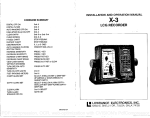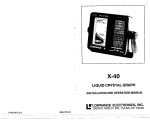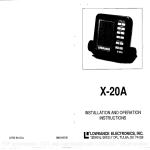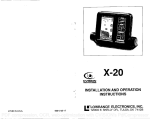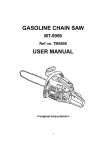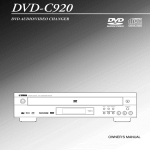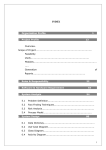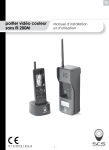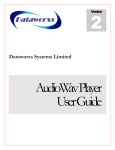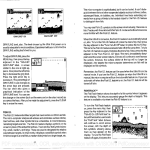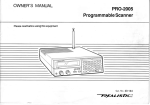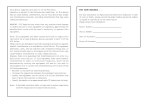Download Z-5000 - Eagle
Transcript
HOW TO OBTAIN SERVICE If you have a problemwith your sonar unit, pleasegive us a chance to help before sending it in for repair. Assistance can often be extendedby telephone or letter. Write or call one of our Authorized ServiceCenters or the Eagle CustomerService Departmentin Tulsa, OK. If you live out of the stateof Oklahoma,call 1 -800-331-2301,toll free. If you live in the state of Oklahoma,call collect 918-266-5373. Pleasedetail the problemyou are experiencing.Our Service Department may be able to saveyou the inconvenienceof returningyour unit 4. If it is determinedthat your unitmust be returned,full shipping instructionswill be provided. SCHEMATICDIAGRAM AND PARTS LIST Should you desire a schematic and parts listfor your Eagle sonar, send $1.00 to the address below and it will be mailed to you promptly. Please be sure and give us the model and serial numberof your Eagle sonar Z-5000 unit. LCG RECORDER Mail To: Eagle Electronics R 0. Box 669 Catoosa,Oklahoma 74015 Installation & Operation Manual C Litho in u.s.A. 9s8-oloe-o7 S PDF compression, OCR, web-optimization with CVISION's PdfCompressor SURVEYING TABLE 0 F C0 NTENTS INTRODUCTION INSTALLATION—Permanent Mount POWERCONNECTIONS MOUNTING—PortableUnits PORTABLE TRANSDUCER KEYBOARD BASICS OPERATION ON 2 2 3 5 6 7 9 9 OFF AUTO SENSITIVITY AUTOMATICSENSITIVITYADVANCED CHART SPEED RANGE LOWER LIMIT ZOOM DIGITAL HT TRANSDUCERS AND CONE ANGLES SIGNAL INTERPRETATION FISH SIGNALS SURFACECLUTTER WATER TEMPERATURE AND THERMOCLINES SURVEYING A LAKE BAIT FISH A LAKE The most successfulanglerson any lake or reservoir are those who fish it dayafter day and year after year until they learn the hot spotsthat produce fish consistently.They discover through experiencewhere,and at whatdepth, they can expect to find the kind of fish they want at any season.And they realizethat these productiveareas change throughout the year dependingon water level,temperature,food, and otherfactors. With the aid ofthe Z-5000, anyone can eliminateguessworkand concentrate on the areas where fish are likely to be—even if its the first timeonthelake! Themost efficentway to become acquaintedwith a body of water is to survey it with your Z-5000. Start out with a map of the lake, if possible, 10 12 and indicate the promisingspots in relationto landmarkson shore: 12 13 As you go about your survey, your Z-5000 will tell youthe depth and kind of bottom. It will also reveal suspendedfish. Multiple signals on the dial usually indicate a good school of fish and it's worth it to stop and fish for them.You maynot get any further 13 14 15 15 16 17 18 20 20 22 22 Keep a few marker buoys in the boat ready to toss overboard.When the Z-5000 indicatesa school of fish, throw a buoy out.Thestring will unwind until the sinker hits bottom.Then, because ofthe marker'sflat shape, it won'tunwind anyfurther With the school thus marked,you can make your turn and come backto fish in exactly the right spot. This is essential when you're far from shore on a big lake. Unlessyou mark the school of fish when you'reover it you may not be able to find it again. BAIT FISH The importance of bait fish to successful fishing can'tbe overemphasized.They are the principle food of all game fish in most waters. Bait fish are the planktonfeeding forage fish, such as minnowsand shad. Bait fish can also be the young of gamefish, such as crappies, bluegill,and bass. Most baitfish are concentrated within five feet of the surfacewhere sunlight promotes the growth of the planktonon whichtheyfeed. One method offishing is to use the Z-5000 to findthe baitfish first.A school of baitfish will look like a "cloud" on the Z-5000's display.Usually, game fish will be nearby, often directly beneaththe school of bait fish. 1 PDF compression, OCR, web-optimization with CVISION's PdfCompressor 22 Most fish don't spawn unless the water temperatureis within rather narrow limits. To find the differenttemperatures,a surface temperature meter, such as the EDT-20 is a valuable aid tc your boat Thisunit providesan extremelyquick responseto identifying the desired surface water spawning temperaturesfor various species.Trout can'tsurvive in strearnthat get too warm; bass and other fish eventuallydieout when stocked in lakes that remain too cold during the summer While some fish have a widertemperaturetolerance than others, each has a certain rangewithinwhich ittriesto stay.Schooling fish suspendedover deep water lie at the level that providesthis temperaturein which, we assume, theyare the most comfortable. The temperatureof water in the lake is seldom constantfrom top to bottom. Layersof differenttemperaturesform, and the junction of a warm and cool layer of water is called a themiocline. The depth and thickness of thethermocline can vary with the season or time of day.In deep lakes there may be two or more at different depths.Thermoclinesare important to fishermen becausetheyare areas where fish are active. Many times bait fish will be above the thermocline while larger gamefish will suspendin or just below it. INTRODUCTION When the Z-5000 Liquid Crystal Graph (LCG) is turned on, it will automaticallyfind and display the bottom signal and other targets. As the depth of the bottom changes, the Z-5000 will automaticallychange the range and sensitivityto always keep the bottom signal on the display.If desired, the only key that needs to be touched is the ON key. However, the automatic mode can be disabled which allows the Z-5000 to be manuallyadjusted. TheZ-5000 is nitrogenfilled and sealed for complete waterproof protection.The liquid crystal display and keyboard are backlighted for easy useat night, plus ifs covered by a full one year warranty which includes all parts and labor for one year from the date of purchase. To get startedwith yourZ-5000, firstread the installationsection. This is whereit all begins,and improper installation can cause problems down the road. Afteryou've read these instructions and installed your Z-5000, read the rest ofthis manual in detail. Themore you know when you getto the water, the more your Z-5000 will do for you. TheZ-5000 can detect this invisible layer in the water,but the sensitivitywill probably have to be turned up to see it. INSTALLATION 011 AUTO. an... Hi Mounting —Permanent V THERMOCLINE Figure 17 LL E::: HE:::::: IEEE Sn TheZ-5000can be installed in any convenient location, provided thereis clearance when tilted for the best viewing angle. Holes in the bracket base allow wood screw or through bolt mounting. Thebracket can be attached to aluminumpanels with sheet metal screws. However, we suggest placing a pieceof plywood on the back of thinfiberglass panels to secure the mounting hardware. Make certain thereis enoughroom behind the unitto attachthe powerand transducer cables. A 11/a" holein the base ofthe gimbal bracket allowsthe power and transducer cables to be routed straight down through the mounting surface.The smallest hole that will pass the transducer connector through is ¾". This will allowthe transducer connector and cable to be passed up through the hole and gimbal bracket,then the power cable wire can be pushed DOWN through the bracket and dash. After the cables have been routed,the holemay be filled with silicone rubber adhesive (RT, or the bracket can be offset so that the majoritypf the hole is covered. PDF compression, OCR, web-optimization with CVISION's PdfCompressor 21 2 Power Connections SURFACECLUTTER TheZ-5000 operatesfrom a 12 volt battery system. Thepower cable can be attached to an accessory or power buss,but if you haveproblems with electrical interference(random dotsor lines that show whenever the boat's engine or an accessory is on), then attach the cable directly to the battery. The markingsat the top ofthe screen representthe surfaceof the waterThey can extend many feet below the surface whichcan interfere with fish signals or othertargets. These markings are called "surface clutter" and are caused by algae, plankton, baitfish, and air bubbles created by boat wakes or wave action. The power cablehas two wires, red is the positive lead and black is negativeor ground.An in-line fuse holder containing a 3 amp fuse is supplied with the Z-5000. This attachesto the red wire on the power cable with the crimp connector. The other end ofthe fuseholder attachesto the battery or accessory buss. If the cable is not long enough, splice ordinary #18gauge wire onto it. Be certain that the fuse holderis as close to the power source (batteryor accessory buss) as possible. Thisprotects the power cable and your Z-5000 in the event of a short. TheZ-5000 is protected from accidental polarity reversals and will not be harmed if the wires are reversed.(However, the unit will not workuntil the correctpolarity is applied.) These marks are normal and can be seen at any time during theyear _________ SENS!TtI/!TY 4&?O 1- : 4%; VOWER tPLE - — SURFACE CLUTTER / S., Figure 16 J -RED ¶\DLDER -8CM 3PCVTER -SIDE OF sgTER'l 3 . Figure1 WATER TEMPERATURE AND THERMOCLINES Water temperaturehas an important—if not controlling influenceupon the activities of all fish. Fish are cold blooded and their bodies are always the temperatureofthe surroundingwater. During the winter, colder water slows down their metabolism so that they need about a fourth as much food as theyconsume in the summer. 20 PDF compression, OCR, web-optimization with CVISION's PdfCompressor Remember, theremust be some movement betweenthe boat and the fish to developthe arch. Usuallythis means trolling at very slow speeds with the main engine in gear at a minimum throttle setting. TRANSDUCER Installationinstructionsfor the permanentmount transducer are suppliedwith the transducer in a separate package. Please read the instructions carefullybefore you start installingthe transducer. The depth of the water will affect the size and shape of the fish arch due to the cone angle diameter. For example, if the cone passes over a fish in shallow water,the signal displayed on the Z-5000 may not arch at all, due to the narrow conediameterand the resolution limitationsof the display.Even the 20 degree transducer has only a 3 foot diameterat this depth. NOISE Electrical noise picked up by the power cablecan be minimizedby routing it away from other possible sources of electrical interference.One ofthe largest noisegenerators is the engine'swiring harness that runs from the engineto the instrumentpanel. This harness usually contains a wire for the tachometerwhich radiates RF (radio frequency)energy. For best results, keep the power and transducer cables away from the engine wiring. Also, bilge pumpwiring can sometimes radiate noise so try to keep the Z-5000's cablesaway fromthose wires. Comparedto a paper graph, an Z-5000cannot show as fine of detail becausethe pixels (dots on the screen) are much larger than a paper graph's markings.Therefore,the Z-5000cannot show fish arches as well as a graph,and it requiresa bit more work initiallyto read and interpret the screenthan a paper graph. Very small fish probably will not arch at all, whilemedium sized fish will show a partial arch, or a shape similar to an arch if they're in deep water Large fish will arch, but the sensitivityneeds to be turned up in deeper water to see the arch. Because of waterconditions,such as heavy surface clutter, thermoclines,etc.,the sensitivity sometimescannot be turned high enough to get fish arches. One of the best ways to get fish arches is to expand or "zoom" a segment of the water,for example30 to 60 feet Thesmaller the segment, the betterthe screen resolution will be. Then, turn up the sensitivityas high as possible without getting too much noise on the screen.In medium to deep water,this method should work to display fish arches. VHF radio antenna cables radiate RF energy at higher power levels than even the engine'swiring harness.It is very importantto keep the Z-5000's power and transducer cables as far away as possible from a VHF radio antennacable. • • In [LI U ______ I.' Figure 15 a If there is no noise—interference—onthe unitwhen the boat is sifting still with the engine running in neutral, but interferencebegins at slow boat speeds,worsening as the boat speed increases,then a probable cause is acoustic noise, or cavitation.This noise is not electrical, but rather mechanicallyinduced noisefrom the transducer.Usually, acoustic noise is created by air bubbles passing over the face ofthe transducer. Thefaster a boat travels, the more air bubbles increase and generate noise on the display.To eliminatethis problem, read the transducer owner's manualfor proper mounting techniques. I Ilk' - _rJ PDF compression, OCR, web-optimization with CVISION's PdfCompressor 19 4 lVlounting—Portable Units Only FISH SIGNALS Installing the Batteries The signals displayed on theZ-5000by fish canbe identifiedby various shaped markings in certain patterns,as opposed to random marks created by noise, or the solid, continuous markings made by the The Z-5000 portable requires two six-volt lantern batteries.To install them,turn the battery box upside down and releasethe two latches on the front of the compartment.Open it and slide the two batteries intothe casewith the spring terminals against the battery board. (Note: the battery board may need to be placed in its slot before installingthe batteries.)Thebattery board is specially designed to assure proper contact with the terminals,regardless of their position. Close the compartmentlid and latch the case. Plug the power cable into the back of the sonar unitand turn it on. TheZ-5000 should begin working. If it isn't check the batteries for proper voltage.Most of the complaints receivedabout portable unitsresult from using stale batteries.All carbon batteries have a limited shelf life. Be sure the batteries you buy are fresh stock. Always remove them from the compartmentbefore storing the unit as dead ones can leak and corrode the plating on the battery board. Figure 2 bottom. Individualfish can, at times, be distinguished by a characteristicarch that separatesthem from theirstationary surroundings.Thereason for this is shown below. The distanceto a fish when it moves into the sonar's cone ofsound is shown as "A" Figure 14. When the fish has moved into the center of the cone, the distance to it will be shorter,"B", and as it moves out of the cone, the distance will increaseagain as shown in "C". If a partial arch occursmost of the time on your unit (the mark curves up, but not backdown, or vice-versa) it could bethe transducer is not pointedstraight down. If the transducer is mounted on the transom, adjust it until the fish show the distinctivearch. This may take some trial and erroruntil the correctmounting is achieved. ri 'IIIIIHI U B At Figure 14 5 18 PDF compression, OCR, web-optimization with CVISION's PdfCompressor The20 degree transducer is almost always the best to use in fresh Portable Transducer water, while the 8 degreetransducer is used mostly in salt water. In a deep water environment, (300feet—fresh water, 100 feet—saltwater) the The portabletransducer is attached to the transom of the boat by means of a suction cup.The transducer should be mountedon an area ofthe transom that is free from bubbles whilethe boat is running.This is important becauseair bubbles cause cavitationnoise which is displayed on the Z-5000 as randomdots. narrow cone angle is more desireable becauseit can penetrateto much deeper depths since the sound energy is concentrated in a smallerarea. Both 8 degree and 20 degree transducers give accurate bottom readings, even though the bottom signal is much wideron the 20 degree model becauseyou are seeing more of the bottom. Remember, the shallow edge of the signal shows youthe true depth. The rest of the signal tells you whether you are over rocks, mud, etc. Assemblethe transducer as shown in Figure 3. Make certain to tie one end of the cord providedwith the transducer to the boat and the other end to the transducerbracketThis will preventthe loss ofthe transducer should it come off. Transducers on salt waterboats need to be paintedwith a thin coatof anti-foulantpaint to prevent organismsfrom growing.If unchecked, barnaclesand other marine growth will cause a decrease in the transducer'ssensitivity. Do not use a metal based anti-foulant paint as it will decreasethe transducer's senstivity. There are special anti-foulant paints specifically designed for transducers.They're readily available at most marine dealers. Cleanthe chosen area of the transom before setting the suction cup. Once the position has been determined,moisten the suction cup and attach it as firmly as possible.The suction cupshould be mounted just above the bottom edge of the hull, which allows the transducer to be in the water at all times. SIGNAL INTERPRETATION Becauseyour Z-5000 is both extremelysensitiveand powerful, it can give you an accurate picture of the kind of bottom over whichyour boat is passing. A bottom of firm sand, gravel, shell, or hard clay returns a fairly wide signal. If the automatic sensitivity is turned off, and the signal narrows down, then it meansthat you have moved over a mud bottom becausemud absorbs the sound wave and returnsa weak signal.Turn up the sensitivity. Ifyou have the automatic senstivityturned on, watch the sensitivity bar As the boat passes over the mud bottom,the Z-5000 will automaticallyincreasethe sensitivityto maintaina good bottom signal. Thesensitivitybar will help you in determining if the bottom is soft or hard. If it increaseswhilein the same depth of water, then the boat has moved over a soft bottom. If it decreases,then it is over a hard bottom. Of course,as the water depth increases or decreases,the sensitivitywill also change. p Big rocks or stumpson a smooth bottom send back signals above the bottom level signal.The height of the signal depends on the target's height. If you watch as you approach a post or atree stump, it will be clearlyvisible as a short line extending above the bottom signal. Figure 3 Brush usually lies on the bottom and shows up as clumps rising above the bottomsignal. Brush signals look similar to large rocks, howevertheir signal is not as strong as rock. PDF compression, OCR, web-optimization with CVISION's PdfCompressor 17 6 TRANSDUCERS AND CONE ANGLES KEYBOARD BASICS SENSITIVITY CHART Thechartspeed is controlred bytheCHARTgroup of keys. TheZ-5000 has 32 chartspeeds, rangingfromvery slowto FAST. Pressingthe FASTkey speeds upthechart speed. Theslowkey reduces it Thechartdisplay can be slopped and started again by pressing both arrow keys at the same Uma LIGHT Thesound waves fromthe transducer spread out into the water in a coneshaped beam, much like the beam from a flashlight. The angle betweenthe outside edges of the cone is called the cone angle. Eagle offers a choiceof transducers with either an 8 or 20 degree coneangle that will interchange with any of the 192 kHz sonar products. In otherwords, anyEagle sonar instrument can be used with any Eagle transducer of the same frequency with no loss of performance. However, the use of any other manufacturers'transducer will result in a loss of performance. Generally, wide cone angle transducers (20 degrees)are ideally suited for operatingin shallow to medium water depths.The 20 degree cone angle allowsyouto seemore ofthe underwaterworld. In 15 feet of water the 20 degree cone covers an areaabout six feet across. The 8 degree transducer covers only about atwo foot circle. ZOOM The range can be expanded or zoomed" on the display byusing this key. Depth 50 1100 lisa 1200 - cone Angle 50' Diameter 7ff. 14 21 28 188. 35• 53• 71 100' Figure 13 ON OFF Thesekeysturn theZ-5000 on and off. Toturnit on, simplypress theON key.To turnitoff, press theOFFkey. 150' Figure 4 200' 80at3db 7 16 PDF compression, OCR, web-optimization with CVISION's PdfCompressor DIGITAL A completedigital sonar is built inside the Z-5000. It automatically discriminatesbetweenthe valid bottom echoes and false echoes from fish, thermoclines,or other signals.The digital display will show only the bottom depth. When the Z-5000is firstturned on, the digital will flash "0" until it has "locked on" to the bottom signal.Once it has acquired the bottom depth, it will displaythe depth in the lower left of the display. t 0 AUTO 2 4 A /' I?' 4 t1"..tfls "Jill-'-—- SENSITIVITY These keys control thegraph's sensitivity. (rhe digital's sensitivityis automaticallyadjusted4lhe receiversensitivity has 32 speeds whiph allows adiustmentoverawide range of conditions.The left arrowkey decreases thesensitivity,the rightarrowkeyincreases it, AANGE Therange keys allow yob to'setect different depth ranges by pressing theup or down arrow. The available ranges.are:10,20,40,60,100, 200, and 400. 6 L. ____ LIGHT tn k=ks -fl + + - SEWSWVIIV -4 SENSITIVITY rzooM — Figure 12 ]EL AUTO TheAUTO key switches theZ-5000 in cr out of the automaticmode, When the Z5000 isfirstturned on, it automaticallyadjusts the sensitivity and range selection, thidtheword "AUTO" will be displayed near thetopofthe screen. Bypressing the AUTO key,you can take control of the Z-5000, making manual adjustments as desired, When the Z-5000 is in theautomatic mode,the word "AUTO" willbe displayed near thetop of the t_OFFJrON_I Although it is not necessary in normal use,to get the maximum performanceout of your digital sonar, stop the chart by pressingboth arrow keys in the chart section of the keyboard. This turns the Z-5000 into a digital sonar only and allows it to better track the bottom signal. One reason to usethe digital in this mannerwould be ifyou are going to travel at high speed from one partof a lake to another and you just want to know the bottom depth. The digitalis turned off whenever the Z-5000 is taken out of the automaticmode. LIGHT A light is provided for operationof the Z-5000 at night. When the unit is L display, Figure 5 first turned on, the lights will flash for 6 seconds.Thesensitivitykeys are used to turn the lights off and on. To turn the lights on, simply press both the left and right arrow keys at the same time and the lights will stay on. To turn the lights off, press both arrow keys atthe same timeagain. The lights will also go outwhenthe Z-5000 is turned off. PDF compression, OCR, web-optimization with CVISION's PdfCompressor 15 8 nnrn ATIflkI I—flflI I'.tI1 When the Z-5000 is firstturned on, it automaticallyfinds and displays the bottom depth, sets the sensitivity level, and much more. Ifdesired, the Z-5000 can be left in this automatic mode and used for finding fish and the water and bottom conditions they prefer. However, virtuallyevery function of the Z-5000 can be manually adjustedso that "fine tuning" of the unitto the surroundingconditions can be made. For example, to setthe range from 0 to 60 feet, press the down arrow key until the lower limit on the display reads 60. NOTE: althoughthe maximumlower limitthe Z-5000can display is 400 feet the actual depth that the Z-5000 can reach is dependent on waterand bottom conditions, plus the quality of the transducer installation. Thelower limit can be changed even if the Automaticfunction is on. theZ-5000 won't accept an entry if a lower limit is selected that is less than the depth of the bottom whilethe Z-5000 is in the Automatic mode. For example, if the Z-5000 is in Automatic,and the range is 0 to 100 feet, with a bottom signal at 80 feet and you select a lower limit of 60 feet the Z-5000 will leave the lower limit at 100 feet However, [ON V ON GSENS)TV!TY U!] The ON key is located in the lower right corner ofthe keyboard. It is placed in this location so that it can be easily found—even at night To turnthe Z-5000on, press the ON key. Thechart lights will begin flashing, then stop aftersix seconds.The chart will begin scrolling across the display and the number"0" will flash. This numberis the digital bottom depth display.Afterthe unithas found the bottom, the depth will be Efl A displayed. OFF LOFF SCALE MARKERS J 10 To turn the Z-5000 off, press and HOLD the OFF key until the display is erased. Figure 10 nil aM ' Figure 11 ZOOM ZOOM AUTO rAuTO _______I When the Z-5000 isfirstturned on, the automaticmode is on. To switch it into the manualmode, press the AUTO key which is located above the ON key. ThewordAUTO at the top of the display will be erased, auto sensitivityand auto ranging will both be cancelled, plus the digital display will be turned off and you will have complete manual control ofthe Z-5000. The Z-5000 can be returned to the automatic mode at any time by simply pressingthe AUTO key again. 9 t______ Often it's desirableto expand or "ZOOM" a section of the displayto showmore detail. Pressingthe ZOOM key aliows you to doublethe size of the targets shown on the lower half of the display. For example, if it's in the manual mode and the range is 0-60feet, press the ZOOM key. The new range will be 30 to 60 feet The segmentsize or distancebetween the upper limit and lower limit will be displayed on the screenfor six seconds, then disappear. In this example, the segment size is 30 feet The segmentsize is displayed in the upper middle ofthe display. After6 seconds it will disappear. PDF compression, OCR, web-optimization with CVISION's PdfCompressor 14 If the automaticmode is on, the maximumchart speed cannot be reached.Turning the automatic mode off will allow the maximumchart speed to be attained. There are 32 steps of chart speed in manualmode and 31 steps in automatic. ____ SENSITIVITY LIGHT SENSITIVITY At times it is desirableto stop or "freeze" the displayto examinean echo before it scrolls off the screen.Pressing both the right and left arrow keys in the chart section at the same timeonce will freezethe display.While the display is stopped,the top line on the display will flash on and off to signifythat the unit is in the freeze mode.Pressingboth arrow keys again will start the display moving at the last chart speed setting. If the digital sonar is on, the bottom will continueto be displayed on the screen.Thedigital does not stopwhen the chart is in the "freeze" When firstturned on, the Z-5000is in the AUTOSEARCH mode. This meansthe sensitivityand range are automaticallyadjusted by the microcomputer to find and lock onto the bottom.The sensitivitycan be left in the automatic mode or it can be manually adjustedto suit conditions. The sensitivitylevel is displayed by a horizontal bar at the top of the display.When the sensitivity is at minimum,the bar is very short. As sensitivityis increased,the bar will travel to the right increasing in length correspondingly.When the sensitivity is set to maximum, the bar will extend across the top of the display. mode. I RANGE I__+ + srJsIrl'!TY SENSITIVITY BAR Whenthe Z-5000 is in the automatic mode,the rangeswill automaticallychangeto keep the bottom signal on the display as the bottom depth changes. At times, however, it may be desirable to expand the range or zoom in on a target Theupper limit can be set to halfthe lower limitsetting by usingthe "ZOOM" key described later in this section. — o AUTO. I— •rnr.rr fr The depth range is always displayed at the top and bottom ofthe display. The scales marked on the sides of the displaywill help you determinethe depth of a target. On the 0-10foot range,each mark indicatesone foot, while on the 0-20foot scale each mark indicates two feet, etc. Thescale markerscan also be used on ranges deeper than 60 feet For example, if the range is 0-100 feet, each mark is equal to 10 feet. I. —S Figure 6 LOWERLIMIT To manuallyadjust the sensitivity, press the AUTOkey once, and auto sensitivitywill be turned off. Theword AUTOatthe top of the display will disappear, signifying that the Z-5000is in the manualmode.To increase the sensitivity, press and hold the right arrow key until the sensitivity is at the desired level.Theleftarrow dec.reasessensitivity in the same manner. Notice how the sensitivitybar moves as you change settings. When you press the right arrow key, the bar moves to the right indicating an indrease in sensitivity. Pressingthe left arrow key moves the bar to the left, indicating the sensitivity hasdecreased accordingly. You'll also see the change on the display. To changethe lower limit, firstmake certain the word "AUTO" is not displayedat the top ofthe screen,signifying that the automatic mode is off. (Note: Thisalso disables the automatic sensitivityfunction.)If the automaticmode is on, press the AUTO key once to disable it. Next, press the down arrow key in the RANGE section of the keyboard.Eachtimethe down arrow is pressed, the lower limit will switch to the next deeper scale. Pressing the up arrow key will change the lowerlimit to the next shallower scale.Theavailable depth ranges are 10, 20, 40, 60, 100, 200, and. 400feet. Thedisplaywill immediatelychange to the new depth range and displaythe new lower, limit at the bottom ofthe screen. 10 13 OCR, web-optimization with CVISION's PDF compression, PdfCompressor . Figure 7 demonstratesa graph with too little sensitivity, whileon the right, the sensitivityis adjusted properly;a fish is now visible, the surface clutter is more pronounced, and the bottom signal has widened. SENSITMTY TOO LITTLE SENSITM1Y ADJUSTED PROPERLY to 1 —I 4 * When the Z-5000 is in the automatic mode,the sensitivity of the receiver will be adjustedto ten stepsabove the minimum required to pick up the bottom signal. (There are 32 steps of sensitivityavailable.) Thesensitivitylevel can be changed whilethe Z-5000 is in the automaticmode.Thismay be desirable if the level of sensitivity chosen by the Z-5000 is not enough to show fish or other small detail, or if it too high for water conditions. Oncethe sensitivityhas been changed, the Z-5000 will increasethe sensitivityenough to pick up the bottom signal,then add in the level you programmed.If desired,any amount of sensitivityup to the maximum may be added. i _________SEWS)?!WIlY 2 AUTO SENSITIVITYADVANCED OPERATION lo To adjust the sensitivitywhile theZ-5000is in the automaticmode, simply press either the right arrow key> to increasethe sensitivityor the left arrow key < to decrease it IT < taw CHART SPEED Figure 7 Figure 8 k=Jfc4i When the Z-5000 is turned on for the firsttime, the chart speed scrolls at a pre-detem,inedspeed. If a higher speed is desired, press and hold the right arrow> key in the CHART section of the keyboard until it runs at When the horizontal bar reaches the far right hand side of the screen, the sensitivitylevel is at maximum,If high sensitivitysettingsare used, a second bottom echo may appear. This is normal and is caused by the returning signal reflecting off the surface ofthe water,making a second trip to the bottom and back again.This is caVed"second echo". To turn Auto Sensitivityback on, press the AUTO key. Remember, both automatic sensitivitycontrol and auto ranging functions are turned off and on at any time by pressing the AUTO key. Thetwo controls cannot be turned off or on separatelyby pressingthe AUTO key. 11 the desired speed.To slow the display,press and hold the left arrow c key. Whenever either of these keys are pressed, the sensitivitybar at the top ofthe displaywill change to a dashed line and the letters"CHT' will appear in a window nearthe top ofthe display. Thisbar representsthe chart speed. Ifyoupress and hold the right arrow > key for example,the bar will start moving to the right, signifying that the chart speed is increasing.By holding either the right or leftarrow keys, the display can be speeded up or slowed down. When the horizontalbar reaches the far right side ofthe screen,the chart speed is at its maximum value. 111 111111NUN It Figure 9 12 PDF compression, OCR, web-optimization with CVISION's PdfCompressor













